Comprehensive Report: Cross Infection Prevention in Healthcare (DN 12)
VerifiedAdded on 2021/01/08
|10
|2252
|61
Report
AI Summary
This report provides a comprehensive overview of cross infection prevention in healthcare settings. It begins by defining cross infection and outlining methods of prevention, including hand hygiene, waste disposal, and the use of personal protective equipment (PPE). The report then delves into the causes of cross infection, differentiating between infectious and non-infectious agents, and providing examples of transmission processes. Standard precautions are explained, emphasizing their role in controlling infections. The report also addresses the importance of immunization for dental personnel, detailing the time scales for immunizations and infectious conditions affecting adults, such as Hepatitis, Tuberculosis, HIV/AIDS, and Herpes simplex. Furthermore, the report includes a section on chemical decontaminants used in surgery, defines key terms like sterilization, disinfection, and asepsis, and highlights the significance of record keeping and barrier techniques in infection control. The report also discusses blood and body fluid spillages, social cleanliness and the proper disposal of sharps, providing a complete guide to preventing cross infection in clinical environments.

DN 12
Paraphrase This Document
Need a fresh take? Get an instant paraphrase of this document with our AI Paraphraser
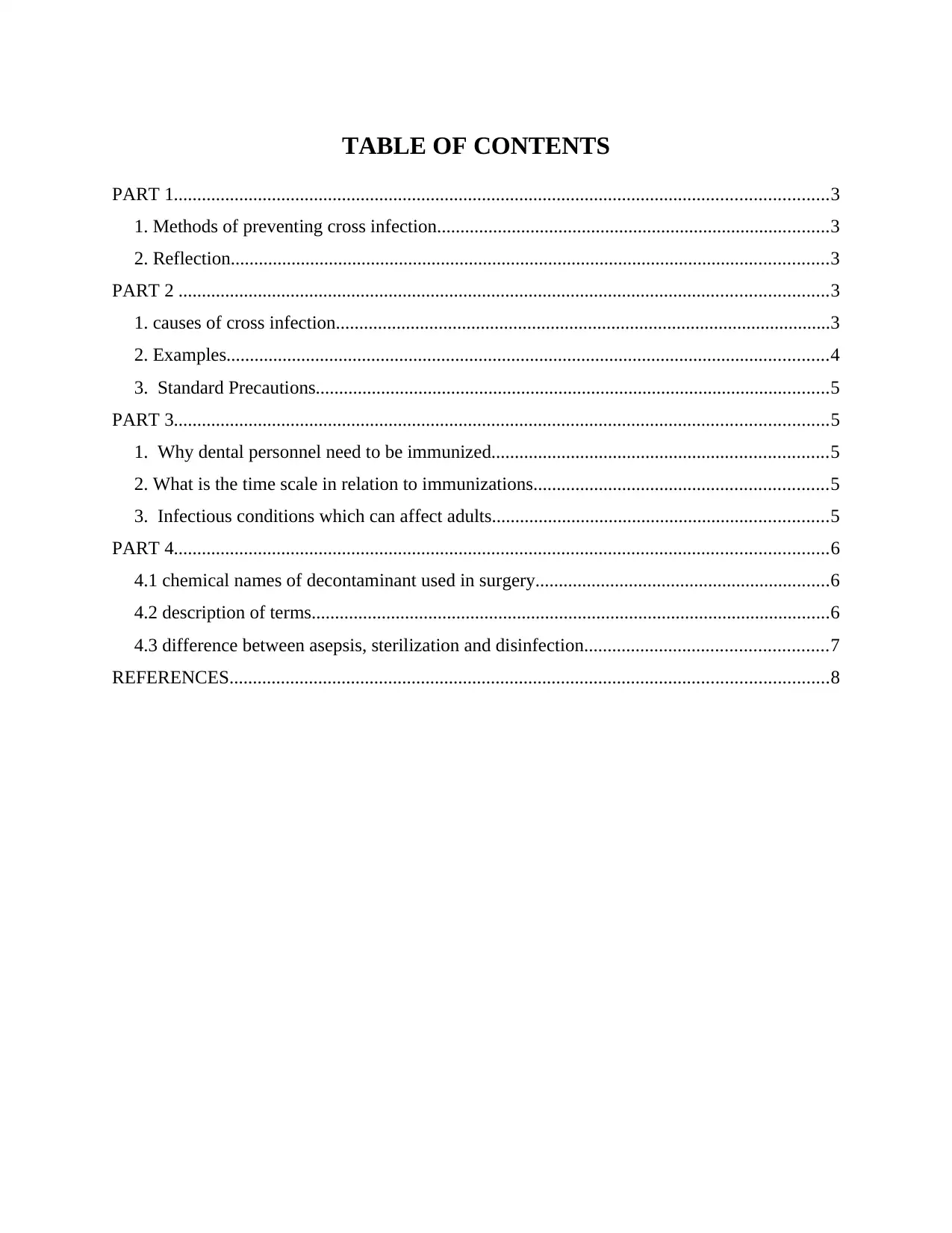
TABLE OF CONTENTS
PART 1............................................................................................................................................3
1. Methods of preventing cross infection....................................................................................3
2. Reflection................................................................................................................................3
PART 2 ...........................................................................................................................................3
1. causes of cross infection..........................................................................................................3
2. Examples.................................................................................................................................4
3. Standard Precautions..............................................................................................................5
PART 3............................................................................................................................................5
1. Why dental personnel need to be immunized........................................................................5
2. What is the time scale in relation to immunizations...............................................................5
3. Infectious conditions which can affect adults........................................................................5
PART 4............................................................................................................................................6
4.1 chemical names of decontaminant used in surgery...............................................................6
4.2 description of terms...............................................................................................................6
4.3 difference between asepsis, sterilization and disinfection....................................................7
REFERENCES................................................................................................................................8
PART 1............................................................................................................................................3
1. Methods of preventing cross infection....................................................................................3
2. Reflection................................................................................................................................3
PART 2 ...........................................................................................................................................3
1. causes of cross infection..........................................................................................................3
2. Examples.................................................................................................................................4
3. Standard Precautions..............................................................................................................5
PART 3............................................................................................................................................5
1. Why dental personnel need to be immunized........................................................................5
2. What is the time scale in relation to immunizations...............................................................5
3. Infectious conditions which can affect adults........................................................................5
PART 4............................................................................................................................................6
4.1 chemical names of decontaminant used in surgery...............................................................6
4.2 description of terms...............................................................................................................6
4.3 difference between asepsis, sterilization and disinfection....................................................7
REFERENCES................................................................................................................................8

PART 1
1. Methods of preventing cross infection
Cross infection refers to transmission of harmful microorganisms like virus and bacteria.
These microorganisms are transferred from one body to another; it can be human beings or
equipment.
Methods of prevention:-
1. Hand Hygiene: - it refers to the washing of hands before from any contact with body.
It is listed in standard precautions list which is followed by doctors and people. After
touching blood, body fluids, contaminated items, hand hygiene is must. After
sneezing or coughing, tissue plays as hand hygiene for human beings.
2. Waste disposal: - it is under policy of medical that management of medical waste
should be done in well manner. It is highly responsible for spreading diseases from
one person to another.
3. Personal protective equipment: - in these used gloves, masks, gowns, eye wear, etc.
are such types of equipment which is responsibility of self to handle and manage
them. It affects on interacting with other persons and control infection.
4. Sharps injury prevention: - in this, safe handling of needles and other sharp
equipment are to be done which is major task for hygienic people. It is or safety
purpose and from controlling infection from one person to another.
2. Reflection
I as a doctor in hospital prepare some plans for clinical area to be hygienic so that
infection does not transfer from one person to another person. As I have analysed that, some
patients do not feel safe in interacting with other patients. So I realized to give mask for each
patient so that chances of transferring microorganisms get decreases. In addition, to supply safe
drinking water in management, it also leads to controlling cross infection.
PART 2
1. causes of cross infection
Cross infection is the transmission of microorganisms from one person to another person.
1. Methods of preventing cross infection
Cross infection refers to transmission of harmful microorganisms like virus and bacteria.
These microorganisms are transferred from one body to another; it can be human beings or
equipment.
Methods of prevention:-
1. Hand Hygiene: - it refers to the washing of hands before from any contact with body.
It is listed in standard precautions list which is followed by doctors and people. After
touching blood, body fluids, contaminated items, hand hygiene is must. After
sneezing or coughing, tissue plays as hand hygiene for human beings.
2. Waste disposal: - it is under policy of medical that management of medical waste
should be done in well manner. It is highly responsible for spreading diseases from
one person to another.
3. Personal protective equipment: - in these used gloves, masks, gowns, eye wear, etc.
are such types of equipment which is responsibility of self to handle and manage
them. It affects on interacting with other persons and control infection.
4. Sharps injury prevention: - in this, safe handling of needles and other sharp
equipment are to be done which is major task for hygienic people. It is or safety
purpose and from controlling infection from one person to another.
2. Reflection
I as a doctor in hospital prepare some plans for clinical area to be hygienic so that
infection does not transfer from one person to another person. As I have analysed that, some
patients do not feel safe in interacting with other patients. So I realized to give mask for each
patient so that chances of transferring microorganisms get decreases. In addition, to supply safe
drinking water in management, it also leads to controlling cross infection.
PART 2
1. causes of cross infection
Cross infection is the transmission of microorganisms from one person to another person.
⊘ This is a preview!⊘
Do you want full access?
Subscribe today to unlock all pages.

Trusted by 1+ million students worldwide

Causes: - bacteria, fungi, parasites, viruses, cause cross infection. These microorganisms are
transferred by contact between infectious one and normal one.
Routes of transmission- microorganisms are transmitted by following process: -
Coughing and sneezing
Human contact
Dirty bleeding
Prolonged use of needles, tubes.
Unsterilized medical equipment
By touching contaminated objects.
2. Examples
Term Infectious/non-
infectious
examples Transmission
process
Pathogen Infectious HIV, Zika and
syphilis
From having direct
contact of one body with
another body. It also get
transmitted through
insect vector or animals.
Non- pathogen Non- infectious E.coli It produces bloody
diarrhea due to toxins.
Bacteria infectious cholera Bacteria are produced
inside the body having
improper food that
makes sick.
Virus infectious HIV, rhinovirus It can be transmitted
through saliva, touch, air.
Like HIV virus also
spread through sexual
contact.
Fungi infectious Tinea pedis,
ringworm
It is spread by having
dirty environment or due
to moist areas
spores Non- infectious Ferns, mosses,
gymnosperms
Spores are agents of
asexual reproduction. It
is produced through
fungi, bacteria, plants
and algae
3. Standard Precautions
Standard precautions are combinations of practices in controlling infections and
preventing from transmitting microorganisms form one person to another person. These
transferred by contact between infectious one and normal one.
Routes of transmission- microorganisms are transmitted by following process: -
Coughing and sneezing
Human contact
Dirty bleeding
Prolonged use of needles, tubes.
Unsterilized medical equipment
By touching contaminated objects.
2. Examples
Term Infectious/non-
infectious
examples Transmission
process
Pathogen Infectious HIV, Zika and
syphilis
From having direct
contact of one body with
another body. It also get
transmitted through
insect vector or animals.
Non- pathogen Non- infectious E.coli It produces bloody
diarrhea due to toxins.
Bacteria infectious cholera Bacteria are produced
inside the body having
improper food that
makes sick.
Virus infectious HIV, rhinovirus It can be transmitted
through saliva, touch, air.
Like HIV virus also
spread through sexual
contact.
Fungi infectious Tinea pedis,
ringworm
It is spread by having
dirty environment or due
to moist areas
spores Non- infectious Ferns, mosses,
gymnosperms
Spores are agents of
asexual reproduction. It
is produced through
fungi, bacteria, plants
and algae
3. Standard Precautions
Standard precautions are combinations of practices in controlling infections and
preventing from transmitting microorganisms form one person to another person. These
Paraphrase This Document
Need a fresh take? Get an instant paraphrase of this document with our AI Paraphraser

precautions are used for taking care of an individual for not to be infectious to others. Hand
hygiene, personal protective equipment, waste disposal, environmental cleaning are some
standard precautions.
PART 3
1. Why dental personnel need to be immunized
Dental hygiene is listed in category 1 level because individual who is suffering from
dental problems are exposed to blood borne pathogens that result in human disease. This is
highly infectious one and can spread in whole body which is very harmful for the individual and
can also result in death. So its need to be immunized within time (Rutala and Weber, 2016).
2. What is the time scale in relation to immunizations.
Immunization is that process through which immune system of individual will be getting
fortified against any other agent like that of immunology. This work when any external molecule
exposes immune system, which is foreign to body. There is time for every disease for
vaccination like for influenza person need to wait for at least 4 weeks to give second live
vaccine. The live vaccines can be given on same day there is 4 day grace period does not apply
to 4 week minimum intervals between 2 different live vaccines. It was included that WHO
recommended that 95% of children in UK must be immunized against mumps and many other
disease.
3. Infectious conditions which can affect adults
Hepatitis- most of the adults are infected by HBV virus who could recovered in 90 days
an if not lifelong immunity could be affected. It could be included that 90% of infants, 20% of
children and 5% of adults will be developing chronic infection and health problems as well as
liver cancer or cirrhosis. HAV is transmitted by faeces of infected person, spread through sexual
practice and by consumption of water. The vaccine of hepatitis B will protect against disease
damaging liver of person. Hand washing before or after contact with blood will be best
pracustion from this disease.
Tuberculosis- the bacteria of TB will commonly grow into lungs of human including
adults, children and people with special need as well. This will include bad cough lasting for 3
weeks or even longer, chest will pain or coughing will also have blood inside lungs. Its bacteria
will get released through air by someone coughs. This could be prevented by isonised which is
form of drug.
hygiene, personal protective equipment, waste disposal, environmental cleaning are some
standard precautions.
PART 3
1. Why dental personnel need to be immunized
Dental hygiene is listed in category 1 level because individual who is suffering from
dental problems are exposed to blood borne pathogens that result in human disease. This is
highly infectious one and can spread in whole body which is very harmful for the individual and
can also result in death. So its need to be immunized within time (Rutala and Weber, 2016).
2. What is the time scale in relation to immunizations.
Immunization is that process through which immune system of individual will be getting
fortified against any other agent like that of immunology. This work when any external molecule
exposes immune system, which is foreign to body. There is time for every disease for
vaccination like for influenza person need to wait for at least 4 weeks to give second live
vaccine. The live vaccines can be given on same day there is 4 day grace period does not apply
to 4 week minimum intervals between 2 different live vaccines. It was included that WHO
recommended that 95% of children in UK must be immunized against mumps and many other
disease.
3. Infectious conditions which can affect adults
Hepatitis- most of the adults are infected by HBV virus who could recovered in 90 days
an if not lifelong immunity could be affected. It could be included that 90% of infants, 20% of
children and 5% of adults will be developing chronic infection and health problems as well as
liver cancer or cirrhosis. HAV is transmitted by faeces of infected person, spread through sexual
practice and by consumption of water. The vaccine of hepatitis B will protect against disease
damaging liver of person. Hand washing before or after contact with blood will be best
pracustion from this disease.
Tuberculosis- the bacteria of TB will commonly grow into lungs of human including
adults, children and people with special need as well. This will include bad cough lasting for 3
weeks or even longer, chest will pain or coughing will also have blood inside lungs. Its bacteria
will get released through air by someone coughs. This could be prevented by isonised which is
form of drug.
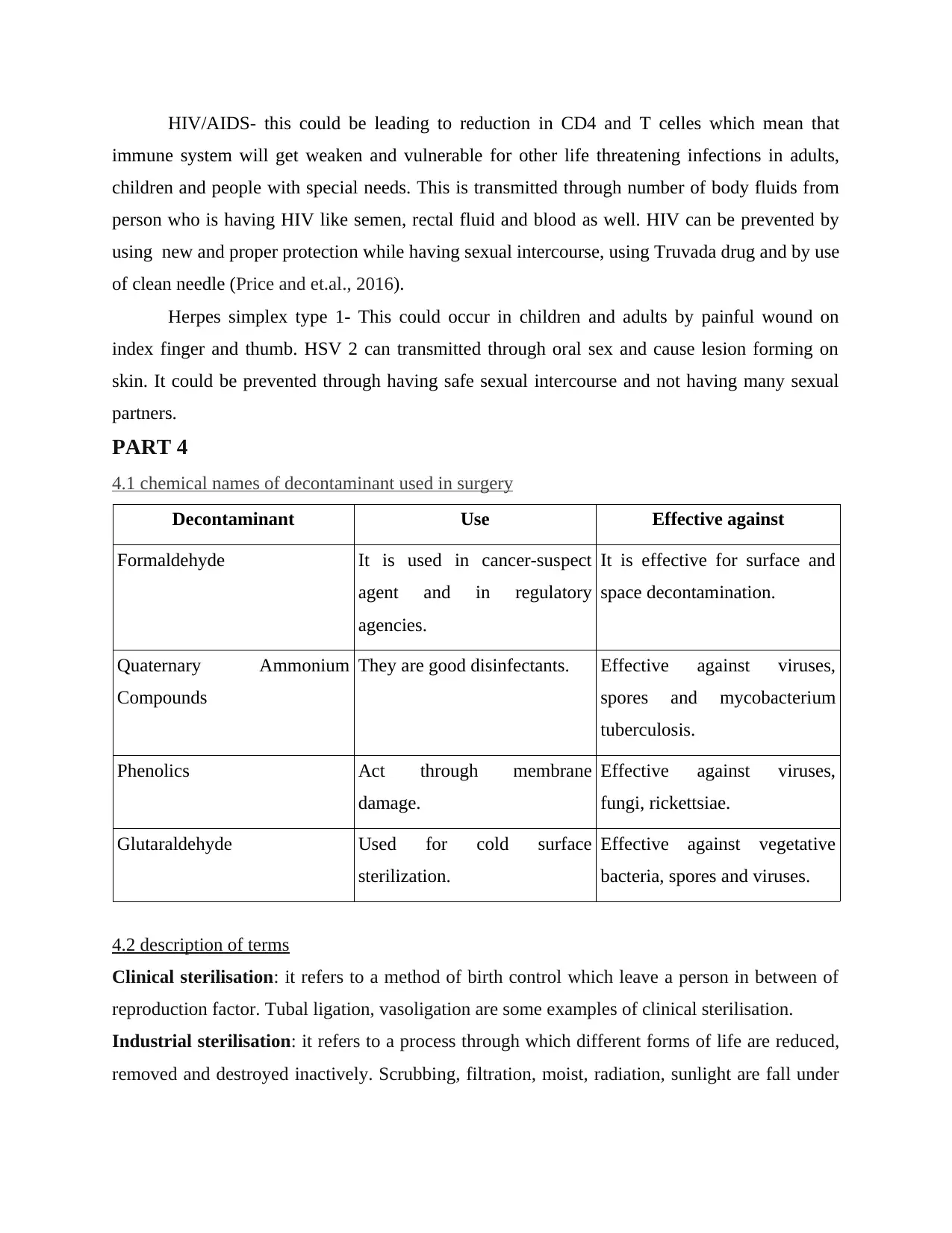
HIV/AIDS- this could be leading to reduction in CD4 and T celles which mean that
immune system will get weaken and vulnerable for other life threatening infections in adults,
children and people with special needs. This is transmitted through number of body fluids from
person who is having HIV like semen, rectal fluid and blood as well. HIV can be prevented by
using new and proper protection while having sexual intercourse, using Truvada drug and by use
of clean needle (Price and et.al., 2016).
Herpes simplex type 1- This could occur in children and adults by painful wound on
index finger and thumb. HSV 2 can transmitted through oral sex and cause lesion forming on
skin. It could be prevented through having safe sexual intercourse and not having many sexual
partners.
PART 4
4.1 chemical names of decontaminant used in surgery
Decontaminant Use Effective against
Formaldehyde It is used in cancer-suspect
agent and in regulatory
agencies.
It is effective for surface and
space decontamination.
Quaternary Ammonium
Compounds
They are good disinfectants. Effective against viruses,
spores and mycobacterium
tuberculosis.
Phenolics Act through membrane
damage.
Effective against viruses,
fungi, rickettsiae.
Glutaraldehyde Used for cold surface
sterilization.
Effective against vegetative
bacteria, spores and viruses.
4.2 description of terms
Clinical sterilisation: it refers to a method of birth control which leave a person in between of
reproduction factor. Tubal ligation, vasoligation are some examples of clinical sterilisation.
Industrial sterilisation: it refers to a process through which different forms of life are reduced,
removed and destroyed inactively. Scrubbing, filtration, moist, radiation, sunlight are fall under
immune system will get weaken and vulnerable for other life threatening infections in adults,
children and people with special needs. This is transmitted through number of body fluids from
person who is having HIV like semen, rectal fluid and blood as well. HIV can be prevented by
using new and proper protection while having sexual intercourse, using Truvada drug and by use
of clean needle (Price and et.al., 2016).
Herpes simplex type 1- This could occur in children and adults by painful wound on
index finger and thumb. HSV 2 can transmitted through oral sex and cause lesion forming on
skin. It could be prevented through having safe sexual intercourse and not having many sexual
partners.
PART 4
4.1 chemical names of decontaminant used in surgery
Decontaminant Use Effective against
Formaldehyde It is used in cancer-suspect
agent and in regulatory
agencies.
It is effective for surface and
space decontamination.
Quaternary Ammonium
Compounds
They are good disinfectants. Effective against viruses,
spores and mycobacterium
tuberculosis.
Phenolics Act through membrane
damage.
Effective against viruses,
fungi, rickettsiae.
Glutaraldehyde Used for cold surface
sterilization.
Effective against vegetative
bacteria, spores and viruses.
4.2 description of terms
Clinical sterilisation: it refers to a method of birth control which leave a person in between of
reproduction factor. Tubal ligation, vasoligation are some examples of clinical sterilisation.
Industrial sterilisation: it refers to a process through which different forms of life are reduced,
removed and destroyed inactively. Scrubbing, filtration, moist, radiation, sunlight are fall under
⊘ This is a preview!⊘
Do you want full access?
Subscribe today to unlock all pages.

Trusted by 1+ million students worldwide
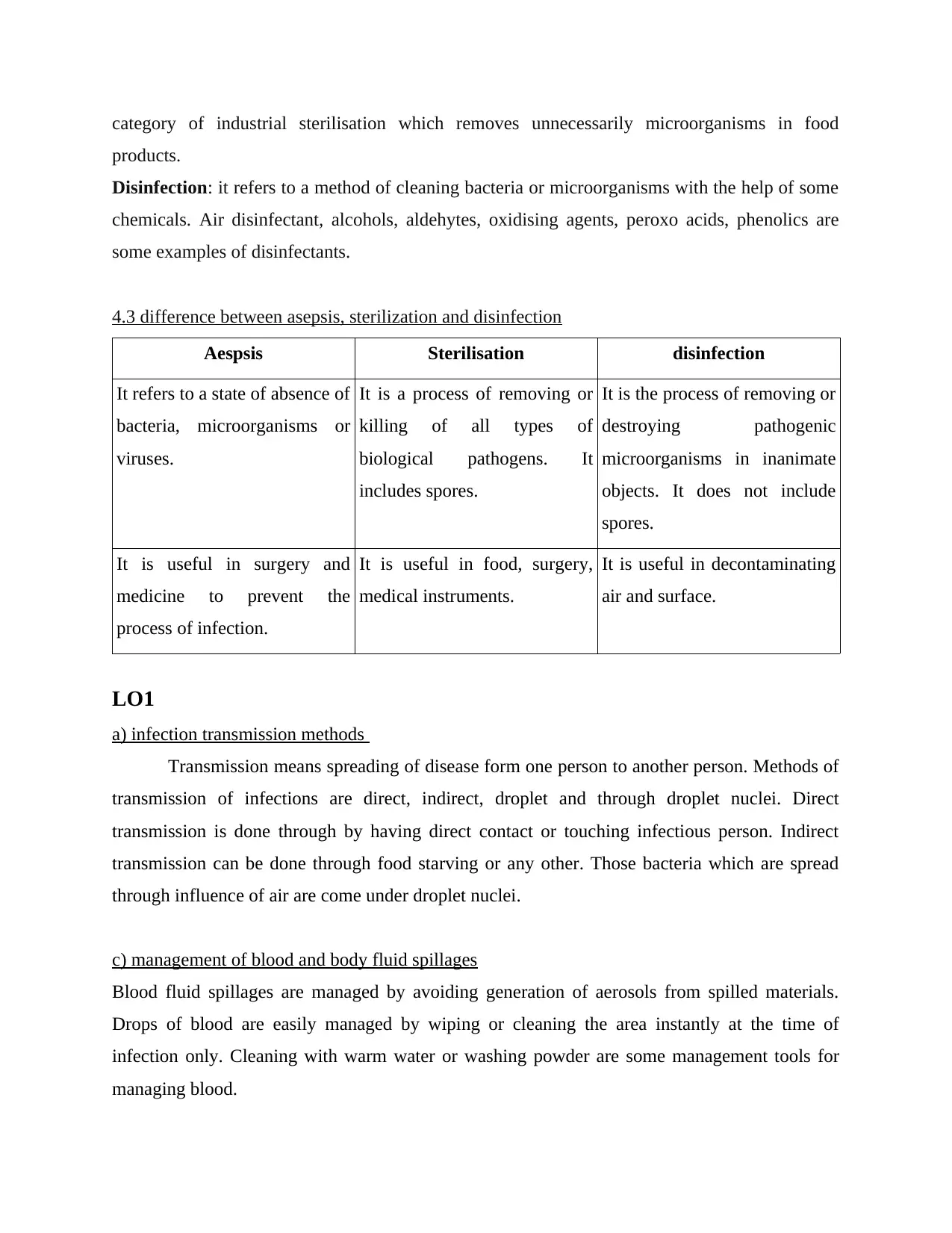
category of industrial sterilisation which removes unnecessarily microorganisms in food
products.
Disinfection: it refers to a method of cleaning bacteria or microorganisms with the help of some
chemicals. Air disinfectant, alcohols, aldehytes, oxidising agents, peroxo acids, phenolics are
some examples of disinfectants.
4.3 difference between asepsis, sterilization and disinfection
Aespsis Sterilisation disinfection
It refers to a state of absence of
bacteria, microorganisms or
viruses.
It is a process of removing or
killing of all types of
biological pathogens. It
includes spores.
It is the process of removing or
destroying pathogenic
microorganisms in inanimate
objects. It does not include
spores.
It is useful in surgery and
medicine to prevent the
process of infection.
It is useful in food, surgery,
medical instruments.
It is useful in decontaminating
air and surface.
LO1
a) infection transmission methods
Transmission means spreading of disease form one person to another person. Methods of
transmission of infections are direct, indirect, droplet and through droplet nuclei. Direct
transmission is done through by having direct contact or touching infectious person. Indirect
transmission can be done through food starving or any other. Those bacteria which are spread
through influence of air are come under droplet nuclei.
c) management of blood and body fluid spillages
Blood fluid spillages are managed by avoiding generation of aerosols from spilled materials.
Drops of blood are easily managed by wiping or cleaning the area instantly at the time of
infection only. Cleaning with warm water or washing powder are some management tools for
managing blood.
products.
Disinfection: it refers to a method of cleaning bacteria or microorganisms with the help of some
chemicals. Air disinfectant, alcohols, aldehytes, oxidising agents, peroxo acids, phenolics are
some examples of disinfectants.
4.3 difference between asepsis, sterilization and disinfection
Aespsis Sterilisation disinfection
It refers to a state of absence of
bacteria, microorganisms or
viruses.
It is a process of removing or
killing of all types of
biological pathogens. It
includes spores.
It is the process of removing or
destroying pathogenic
microorganisms in inanimate
objects. It does not include
spores.
It is useful in surgery and
medicine to prevent the
process of infection.
It is useful in food, surgery,
medical instruments.
It is useful in decontaminating
air and surface.
LO1
a) infection transmission methods
Transmission means spreading of disease form one person to another person. Methods of
transmission of infections are direct, indirect, droplet and through droplet nuclei. Direct
transmission is done through by having direct contact or touching infectious person. Indirect
transmission can be done through food starving or any other. Those bacteria which are spread
through influence of air are come under droplet nuclei.
c) management of blood and body fluid spillages
Blood fluid spillages are managed by avoiding generation of aerosols from spilled materials.
Drops of blood are easily managed by wiping or cleaning the area instantly at the time of
infection only. Cleaning with warm water or washing powder are some management tools for
managing blood.
Paraphrase This Document
Need a fresh take? Get an instant paraphrase of this document with our AI Paraphraser
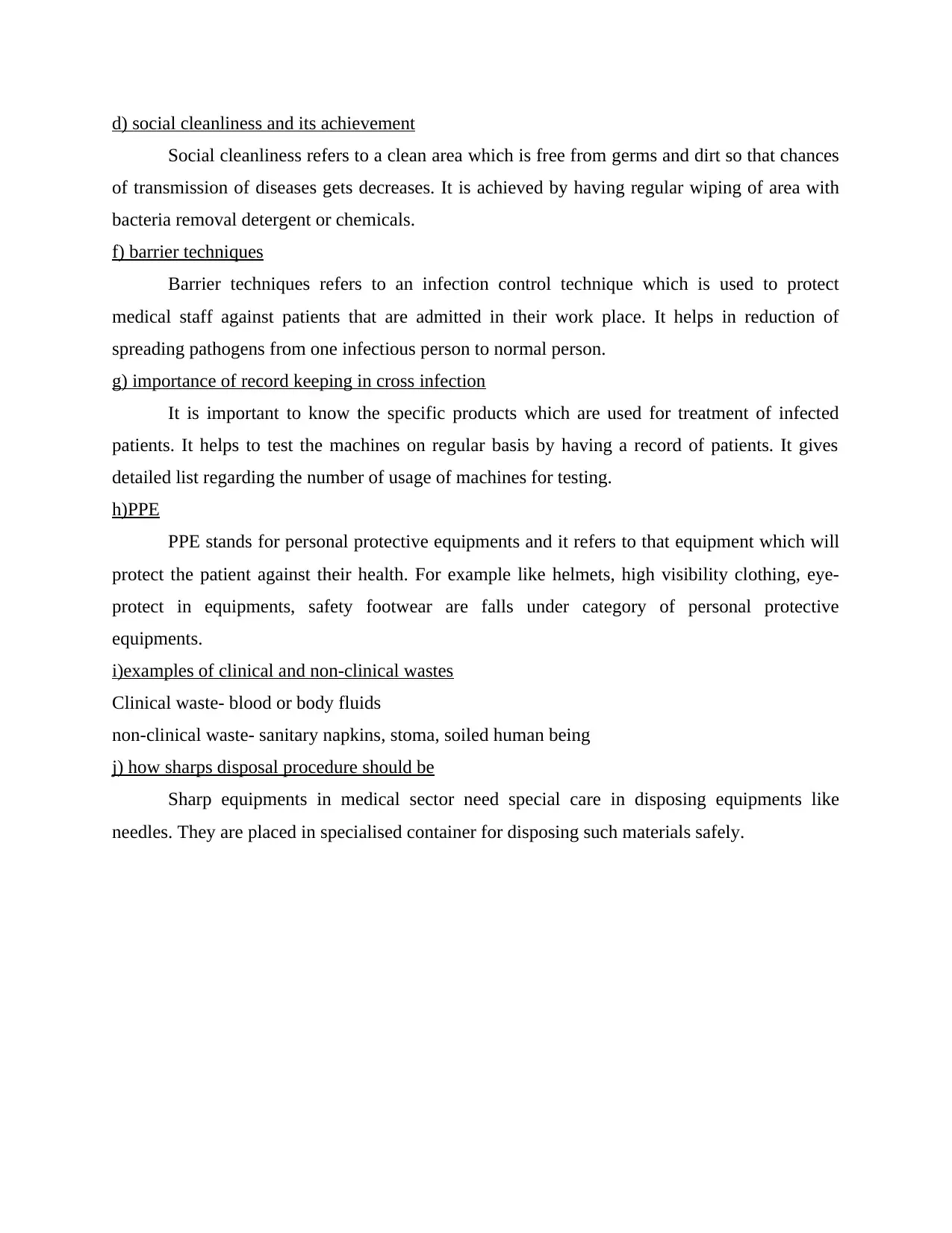
d) social cleanliness and its achievement
Social cleanliness refers to a clean area which is free from germs and dirt so that chances
of transmission of diseases gets decreases. It is achieved by having regular wiping of area with
bacteria removal detergent or chemicals.
f) barrier techniques
Barrier techniques refers to an infection control technique which is used to protect
medical staff against patients that are admitted in their work place. It helps in reduction of
spreading pathogens from one infectious person to normal person.
g) importance of record keeping in cross infection
It is important to know the specific products which are used for treatment of infected
patients. It helps to test the machines on regular basis by having a record of patients. It gives
detailed list regarding the number of usage of machines for testing.
h)PPE
PPE stands for personal protective equipments and it refers to that equipment which will
protect the patient against their health. For example like helmets, high visibility clothing, eye-
protect in equipments, safety footwear are falls under category of personal protective
equipments.
i)examples of clinical and non-clinical wastes
Clinical waste- blood or body fluids
non-clinical waste- sanitary napkins, stoma, soiled human being
j) how sharps disposal procedure should be
Sharp equipments in medical sector need special care in disposing equipments like
needles. They are placed in specialised container for disposing such materials safely.
Social cleanliness refers to a clean area which is free from germs and dirt so that chances
of transmission of diseases gets decreases. It is achieved by having regular wiping of area with
bacteria removal detergent or chemicals.
f) barrier techniques
Barrier techniques refers to an infection control technique which is used to protect
medical staff against patients that are admitted in their work place. It helps in reduction of
spreading pathogens from one infectious person to normal person.
g) importance of record keeping in cross infection
It is important to know the specific products which are used for treatment of infected
patients. It helps to test the machines on regular basis by having a record of patients. It gives
detailed list regarding the number of usage of machines for testing.
h)PPE
PPE stands for personal protective equipments and it refers to that equipment which will
protect the patient against their health. For example like helmets, high visibility clothing, eye-
protect in equipments, safety footwear are falls under category of personal protective
equipments.
i)examples of clinical and non-clinical wastes
Clinical waste- blood or body fluids
non-clinical waste- sanitary napkins, stoma, soiled human being
j) how sharps disposal procedure should be
Sharp equipments in medical sector need special care in disposing equipments like
needles. They are placed in specialised container for disposing such materials safely.
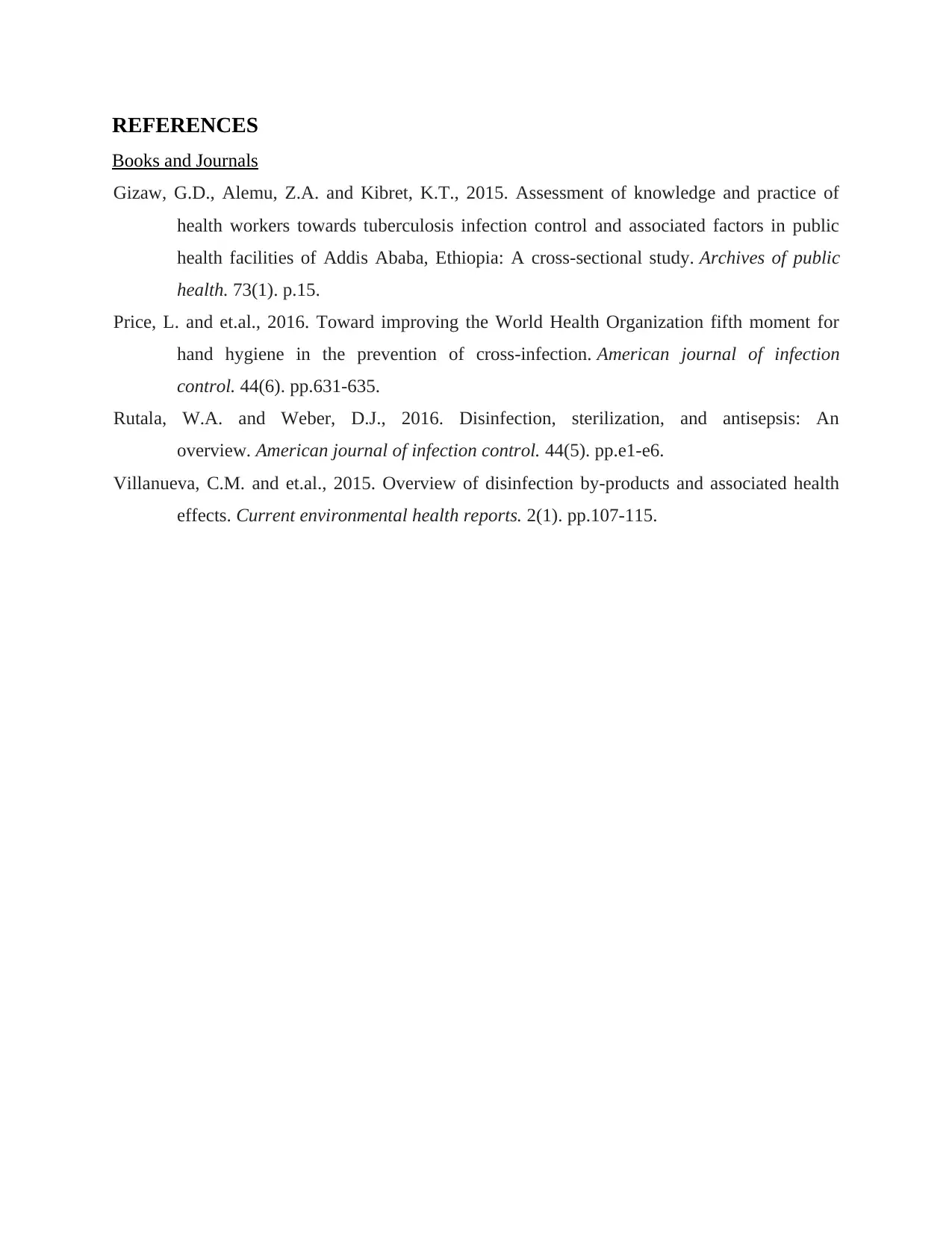
REFERENCES
Books and Journals
Gizaw, G.D., Alemu, Z.A. and Kibret, K.T., 2015. Assessment of knowledge and practice of
health workers towards tuberculosis infection control and associated factors in public
health facilities of Addis Ababa, Ethiopia: A cross-sectional study. Archives of public
health. 73(1). p.15.
Price, L. and et.al., 2016. Toward improving the World Health Organization fifth moment for
hand hygiene in the prevention of cross-infection. American journal of infection
control. 44(6). pp.631-635.
Rutala, W.A. and Weber, D.J., 2016. Disinfection, sterilization, and antisepsis: An
overview. American journal of infection control. 44(5). pp.e1-e6.
Villanueva, C.M. and et.al., 2015. Overview of disinfection by-products and associated health
effects. Current environmental health reports. 2(1). pp.107-115.
Books and Journals
Gizaw, G.D., Alemu, Z.A. and Kibret, K.T., 2015. Assessment of knowledge and practice of
health workers towards tuberculosis infection control and associated factors in public
health facilities of Addis Ababa, Ethiopia: A cross-sectional study. Archives of public
health. 73(1). p.15.
Price, L. and et.al., 2016. Toward improving the World Health Organization fifth moment for
hand hygiene in the prevention of cross-infection. American journal of infection
control. 44(6). pp.631-635.
Rutala, W.A. and Weber, D.J., 2016. Disinfection, sterilization, and antisepsis: An
overview. American journal of infection control. 44(5). pp.e1-e6.
Villanueva, C.M. and et.al., 2015. Overview of disinfection by-products and associated health
effects. Current environmental health reports. 2(1). pp.107-115.
⊘ This is a preview!⊘
Do you want full access?
Subscribe today to unlock all pages.

Trusted by 1+ million students worldwide

1 out of 10
Related Documents
Your All-in-One AI-Powered Toolkit for Academic Success.
+13062052269
info@desklib.com
Available 24*7 on WhatsApp / Email
![[object Object]](/_next/static/media/star-bottom.7253800d.svg)
Unlock your academic potential
Copyright © 2020–2025 A2Z Services. All Rights Reserved. Developed and managed by ZUCOL.





